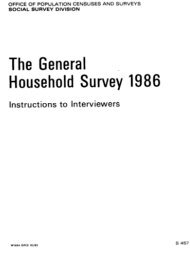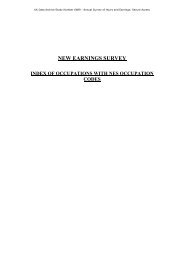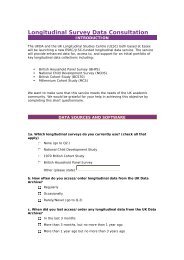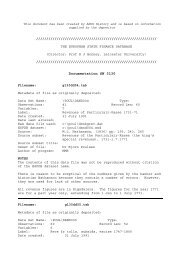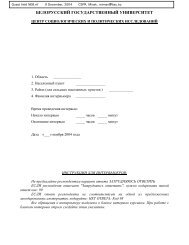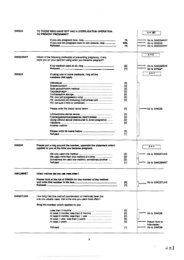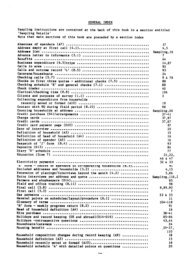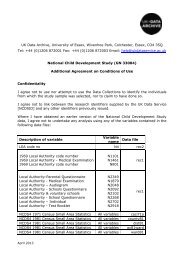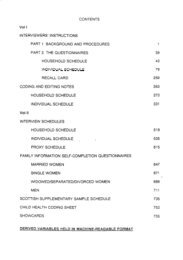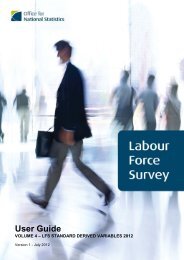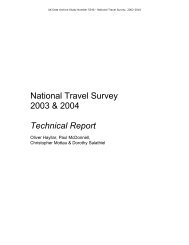ESDS Annual Report, 2008-2009
ESDS Annual Report, 2008-2009
ESDS Annual Report, 2008-2009
You also want an ePaper? Increase the reach of your titles
YUMPU automatically turns print PDFs into web optimized ePapers that Google loves.
<strong>ESDS</strong> Government<br />
Government surveys, especially repeated series,<br />
provide a key resource for UK social science. <strong>ESDS</strong><br />
Government promotes and facilitates effective use of<br />
surveys such as the General Household Survey (GHS),<br />
now renamed the General Lifestyle Survey; the Labour<br />
Force Survey (LFS); the Opinions Omnibus Survey and<br />
the British Crime Survey (BCS).<br />
<strong>ESDS</strong> Government teams at<br />
Essex and Manchester<br />
The work of <strong>ESDS</strong> Government is divided between the<br />
UK Data Archive at Essex and CCSR at Manchester. The<br />
Essex team is responsible for negotiating the deposit<br />
of data with the data producers, for checking the data<br />
quality and documentation, and ensuring the safe<br />
preservation of each file. They also disseminate the<br />
data online and, for most of the <strong>ESDS</strong> Government<br />
surveys, provide the data in Nesstar for the online<br />
exploration of metadata, frequency distributions and<br />
analyses.<br />
The Manchester team is responsible for promoting<br />
and supporting the use of the government surveys<br />
in research and teaching, including answering user<br />
queries and producing enhanced ancillary materials,<br />
made available via the web site.<br />
Promoting use of data in high<br />
quality research<br />
Two important elements of the outreach strategy<br />
address the two ends of the user spectrum. First, the<br />
aim is to increase the use of government surveys in<br />
teaching and learning at under-graduate and Masters<br />
level and, second, to promote greater use of some<br />
of the unique aspects of the government surveys.<br />
These unique aspects include information collected<br />
for all members of the household, organised so that<br />
links can be made between different members of the<br />
same family or household; a long time period thus<br />
facilitating the analysis of change over time; a growing<br />
number of surveys with a true longitudinal dimension.<br />
To achieve these ends the service has consulted those<br />
who teach survey analysis to establish the most<br />
profitable lines of communication. It has also held a<br />
one day workshop for methods teachers to promote<br />
and share information on resources.This has resulted in<br />
proposals to augment our ‘Getting Started’ guides by<br />
posting short videos on the <strong>ESDS</strong> web site.<br />
To promote greater use of the more complex aspects<br />
of government surveys the service has:<br />
> held a workshop on concepts in complex sample<br />
design and the analysis of survey data using Stata;<br />
> developed a new online guide to analysing complex<br />
survey design in <strong>ESDS</strong> Government datasets;<br />
> run a data manipulation workshop for analyses of<br />
surveys at different levels (for example, household<br />
and individual) or which have a complex structure<br />
(where the data is held in a number of separate<br />
linkable datasets or ‘tables’);<br />
> provided a user guide to one of the most complex<br />
government surveys, the Expenditure and Food<br />
Survey.<br />
E C O N O M I C A N D S O C I A L DATA S E RV I C E A N N UA L R E P O RT AU G U S T 2 0 0 8 – J U LY 2 0 0 9 1 1<br />
www.esds.ac.uk/government



